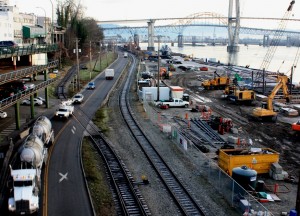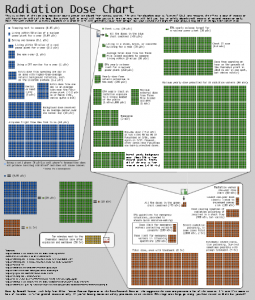There seems to be a lot of talk about Smart Meters. Although the program has been in the works for a couple of years, it was the Green Party who really brought the issue to the front page this summer with their strange dip into the EMF health Scare issue this summer. Now the UBCM has brought the issue into the mainstream, and random, sporadic reports are coming out about how the installation process is causing all sorts of trouble for a very small number of BC Hydro’s 4 million customers.
As complaints about the Smart Meter program keep popping up like some sort of cosmic whinging whack-a-mole game, I keep flip-flopping between supporting them and not supporting them. When the local media asked if the NWEP had a position on the meters, and we had to answer no. There has been lots of discussion at NWEP meetings, and socially amongst the various NWEP folks, and frankly, we do not have a consensus opinion. Some are “for”, some are “against”, and most for very different reasons. I’m going to go through some of the issues, and give my opinions (worth, as always, exactly what you pay for them), about Smart Meters, and address them individually. None of these opinions necessarily reflect the opinions of the NWEP membership.
First off, there is no measurable health risk related to the use of microwave communications for the reading of Smart Meters. This is not only my opinion, it is by far the scientific consensus. If you have a problem with that, take it up with Orac. Frankly, I’m tired of that debate, and would rather argue with Astrologers about how the location of Jupiter when I passed through the birth canal impacted my life.
A second common complaint is a loss of privacy. Some people seem to be afraid that BC Hydro will somehow know when they like to make toast or do laundry. My response to that is also an easy dismissive: who cares? I think that a utility that sells you a service has the right to collect data on how much you use and when you use it, in order to better facilitate billing and to optimize their resource allocation. I am also not so narcissistic to think that my refrigeration or vacuuming habits are of anyone’s interest, as long as I pay my bill, and frankly, I don’t care what your habits are. In a time when people tweet their bowel movements, is your hourly electricity use really a high-security issue? Electricity in BC is a public resource, much like treated drinking water, the minerals in the ground, the trees in the forest, and the fish in the river. Like all of these things (except, paradoxically, water), in order for you to personally benefit from the common resource, you need to pay a little for it, and we also ask that you tell the government how much of the resource you have used and when you used it. This is a fundamental principle of resource management. You always have the option to opt out and go off grid. Good luck.
Probably a better argument against the meters is the apparent lack of a business case. BC Hydro is, believe it or not, still the property of the BC Taxpayers, and no matter how much the BC Liberals try to dice it up, sell it off, and cripple it, there is still strong public support for keeping our electrical utility in public hands. Fundamental to that is that there be transparent oversight by an independent Utilities Commission. From my meagre research, the roll-out of the Smart Meter program has not been public, it has not been overseen, and it has been contracted out to a private company for an unknown and unaccounted cost. The program might be good for BC Hydro and good for all British Columbians, but if that is the case, it should be opened up to oversight and scrutiny (this sounds like an HST argument all of the sudden). Otherwise, it leaves a bad taste, and only fuels the fire of the conspiracy theorists.
My biggest issue with the program is that Darth Coleman keeps on saying that the Smart Meters are not going to be used for the one thing they are good at. It is like he is trading in his K-car for a Corvette and says he doesn’t like to drive fast. I am talking about variable billing based on time-of-use. This has the potential to save BC Hydro a ton of electricity, and us a ton of money, by reducing peak demand, as demonstrated in BC Hydro’s own study of the issue. Ultimately, energy conservation at the “peak” saves us needing to build new generation capacity, and provides a easier planning for a robust energy infrastructure. Just being able to measure and account for peak and off-peak times may provide enough benefit for BC hydro to make the switch worth while, (although, again, I would be a lot more confident in this statement if BC Hydro were to be more transparent around the business case) by charging less at off-peak times to allow those with the ability to use electricity flexibly (industrial users, those charging electric vehicles, house-hold co-generators, people watching Canucks games at pubs instead of at home, etc.)
One of the funnier tropes in this debate is that somehow Smart Meters are a sneaky way to increase power rates. This is wrong on so many levels. I don’t know if anyone noticed, but BC hydro can raise rates without the need for Smart Meters. They would need to demonstrate to the B.C. Utility Commission that there is a genuine need for an organization that belongs to the taxpayers to charge the taxpayer more money for a product that belongs to the taxpayer and is transmitted through infrastructure that belongs to the taxpayer, but that has worked for them in the past. It is perhaps telling of BC Hydro’s broken governance system and the current BC Government’s lack of transparency that they did not have to go to the BCUC to demonstrate the business case for the Meters, but that is a flawed governance issue, not a Smart Meter issue. Whether your electricity is measured by a Smart Meters or analog meters or by handing out batteries has no relation whatsoever to how much money BC hydro can collect from power users. Yes, it provides them flexibility in pricing, but ultimately, the overall cost per KW/h delivered will be the same.
These conspiracies assume that the ultimate goal of BC Hydro is to unnecessarily raise rates. Why? They are not a for-profit organization; they do not pay dividends to shareholders. They do not transfer profits to the Provincial government to make the deficit improve elect-ability. The worst things they do with their money are pay wages to British Columbians and buy equipment and services from BC companies. The senior management would seem to benefit most from providing BC taxpayers with a financially solvent, well-managed and reliable utility that provides us the lowest rates possible, in order to keep the pitchfork-and-torches crowd chasing David Hahn instead of them. This grand conspiracy lacks a plausible benefit, and once again Hanlon’s Razor rears it’s ugly head: Never assume malice when incompetence will suffice.
The issue of Smart Meters did come up in Monday’s City Council meeting in New West. With our own Electrical Utility, the Mayor was quick to point out that the people of New Westminster would be making their own decision about whether Smart Meters or other technologies would be used in New Westminster homes. Perhaps this is a good question to ask Mayor Wright, the Council representative the Electricity Commission, during the election campaign. Does he see wireless Smart Meter technology suiting New Westminster’s Electrical conservation goals? Actually, let’s step back and ask if New Westminster has electrical conservation goals.


